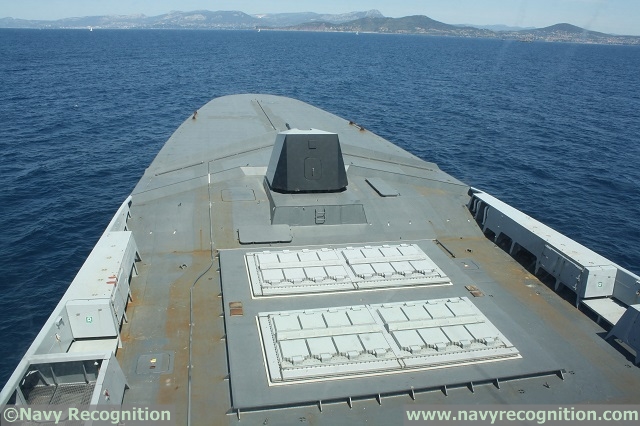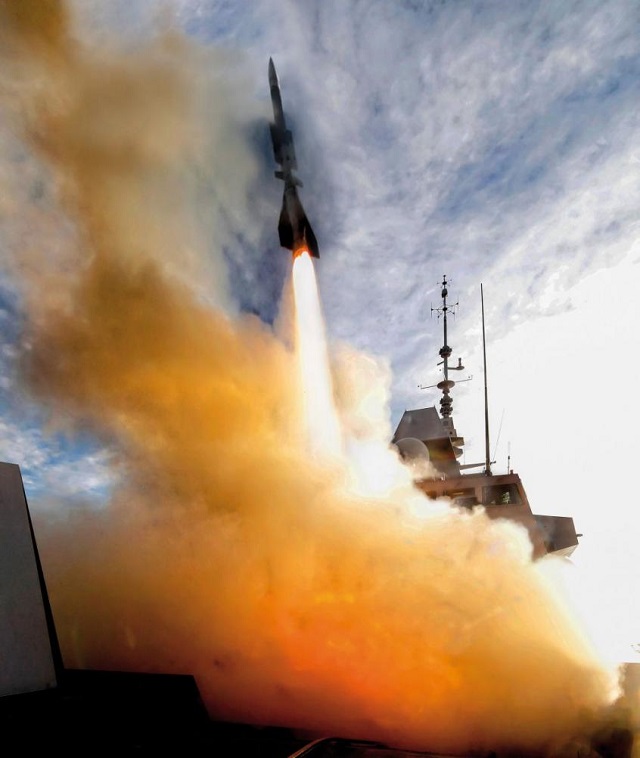| |
|||
| a | |||
Focus - FREDA Air Defense FREMM Frigates |
|||
Details
on the FREDA: The Future Air-Defense FREMM Frigates of the French Navy |
|||
By
Xavier Vavasseur According to the recent update to the French Military Planning Law, the French Navy is set to receive two FREDA (frégate de défense aérienne or air defense frigate) by 2022. Not much information was available so far on the FREDA besides the fact they would be based on the DCNS FREMM (Aquitaine class), get a modified Thales Herakles radar and would likely deploy MBDA's ASTER 30 long range surface-to-air missiles. Navy Recognition contacted both DCNS and Thales to learn more. |
|||
 French
Navy FREMM Frigate Provence (third ship of the class for the
French Navy). Visualy, there should be no notable differences between
the ASW FREMMs currently being delivered by DCNS and the future FREDA.
Picture: Y.Bisson©Marine Nationale French
Navy FREMM Frigate Provence (third ship of the class for the
French Navy). Visualy, there should be no notable differences between
the ASW FREMMs currently being delivered by DCNS and the future FREDA.
Picture: Y.Bisson©Marine Nationale |
|||
Questions
on the FREDA vessels with DCNS. Navy Recognition (NR): Is there a dedicated "FREDA Program" at DCNS or are the two FREDA vessels managed as part of the FREMM program ? Anne Bianchi, FREMM Program Director at DCNS (AB): The FREDA vessels are part of the OCCAR FREMM program (Ed. note: European Organization for Joint Armament Cooperation). This program is managed by the management team of DCNS FREMM program. NR: Will there be some physical and visible differences between a FREDA and an Aquitaine class FREMM ? Will the FREDA be heavier ? AB: No, there will be no visible difference compared to an anti-submarine warfare FREMM. The two vessel types will be in the same class of displacement. NR: Will the FREDA receive a specific combat management system (CMS)? Will it be an evolution of the FREMM CMS or will it be based on the Horizon class? Will the Combat Information Center (CIC) be re-arranged compared to the one currently found on board Aquitaine class frigates ? AB: The specific functions related to air defense missions will be developed from the CMS installed on board anti-submarine warfare FREMM frigates. Regarding the CIC, we will apply adaptability measures such as increasing the number of consoles. (Ed note: but the same hardware/consoles will be used) NR: What will the configuration of the vertical launch system be ? 32x Sylver A50 or 16x Sylver A50 and 16x Sylver A70? Will the FREDA retain the capacity to launch Naval Cruise Missiles ? (Ed. note: A70 is the "strike length" VLS and the current Aquitaine class is fitted with 16x Sylver A50 for Aster 15 missiles and 16x Sylver A70 for Naval Cruise Missiles). AB: The FREDA vessels will be configured with 4x A50 modules (for a capacity of 32x Aster missiles). The Naval Cruise Missile capacity is not expected for FREDA. NR: Except for the weapons and the radar, what are the specifics of a FREDA frigate compared to a FREMM frigate ? Any difference in the size of the crew, peripheral equipment such as jammers, ESM, sonar, narwhal, torpedo... ? AB: There are no configuration differences between the anti-submarine warfare FREMM ships and the FREDA. NR: Finally, on the industrial aspect, will building the two FREDA be slower compared to assembling the ASW FREMM because of their specificity ? AB: The FREDA specificities do not significantly undermine the planning of realization. Compared with ASW FREMM integration times, the first FREDA class ship requires a slightly long final integration time. |
 The
two FREDA Frigates are set to receive a "boosted" variant of
Thales' Herakles S-band multifunction radar. Illustration: Thales The
two FREDA Frigates are set to receive a "boosted" variant of
Thales' Herakles S-band multifunction radar. Illustration: Thales |
|||
Questions
on the FREDA radar with Thales. Navy Recognition (NR): How did Thales managed to increase the detection range of the Herakles ? Thales radar expert (TRE): The increased range is obtained by: • The increase in power (adding additional Tx modules in the transmitter bay) • The generation of new impulses • The creation of a new search/watch mode NR: Does this "new" Herakles radar has a new name ? TRE: No NR: Will this "boosted" HERAKLES be a limiting factor relative to the capacity of Aster 30 missiles? In other words, in case of interception, will the FREDA + Herakles + Aster 30 combination have the same capabilities as the Horizon + Smart L+ Aster 30 combination ? TRE: The Horizon frigates are equipped with SMART-L radar and EMPAR. Aster 30 firing tests (with French and foreign navies) showed that Herakles was very effective in its current configurations. NR: Is there an impact on the current dimensions of the Herakles ? TRE: No impact because predispositions were taken in the initial design. NR: Will this radar provide Anti-ballistic Missile (ABM) capabilities to the FREDA vessels ? TRE: The FREDA ships will not have to conduct ABM missions. NR: Is the installation of adjunct systems necessary for the implementation of this radar ? (More power, more computers etc ...) TRE: There is no installation of additional systems but an evolution of the Herakles system: • Additional Tx modules are added for the "boosted" version of Herakles, requiring adjustment of the setting of the Tx modules cooling system. • Changes in certain subsets of the radar was necessary to generate new impulses and the new "Long Range" search/watch mode (signal generation, treatment, ...) NR: Will there be a test phase at the shore integration facility (in St. Mandrier) ? TRE: This is not planned for FREDA. NR: Finally can you confirm the range increase of 50 Km for the "boosted" Herakles (from 250 km to 300 km) ? TRE: We can not mention any numbers, we can just mention a significant increase in range. |
|||
 View
from an Aquitaine class FREMM Frigate. The VLS at the foreground are SYLVER
A70 for MBDA's Naval Cruise Missile while the VLS row in the background
are SYLVER A50 to deploy the Aster family of surface to air missiles.
The FREDA are set to receive 32x A50 cells for Aster 15 and Aster 30 SAM.
The SYLVER family of VLS is designed and made by DCNS. View
from an Aquitaine class FREMM Frigate. The VLS at the foreground are SYLVER
A70 for MBDA's Naval Cruise Missile while the VLS row in the background
are SYLVER A50 to deploy the Aster family of surface to air missiles.
The FREDA are set to receive 32x A50 cells for Aster 15 and Aster 30 SAM.
The SYLVER family of VLS is designed and made by DCNS. |
|||
With
those answers from DCNS and Thales, it seems clear now that the two FREDA
vessels will very much be FREMM frigates with increased air defense capabilities.
With their focus on air defense roles, they lost their Naval Cruise Missile
capability (this appears to be a choice of the French Navy more than a
technical limitation) but they will still be potent ASW tools: They will
keep the CAPTAS-4 sonar of the FREMMs, one of the best variable depth
sonar available today. |
|||
 An
Aster 15 medium range surface to air missile is launched from FREMM Aquitaine,
first ship of the class. Picture: MBDA An
Aster 15 medium range surface to air missile is launched from FREMM Aquitaine,
first ship of the class. Picture: MBDA |
|||
While the FREDAs may not be as capable as an Horizon class Guided Missile
Destroyer (Forbin class designated Frigate in the French Navy), they will
non-the-less be superior in every aspect to the two Cassard
class AAW Frigates they are set to replace. DCNS was able to leverage
the multi-mission qualities of the FREMM platform to answer the needs
of the French Navy for two capable and modern air defense frigates. The two FREDA will be the last FREMM type frigates produced by DCNS for the French Navy as France launched a new program, the FTI (Frégate de Taille Intermédiaire or Midsize Frigate). The first of five FTI frigate is set to be delivered in 2023. During a recent press event which we were attending, DCNS CEO Hervé Guillou explained that his company already received a contract for preliminary studies and that DCNS was studying several FTI designs to best match the needs of the French Navy as well as those of the export market. |
|||










